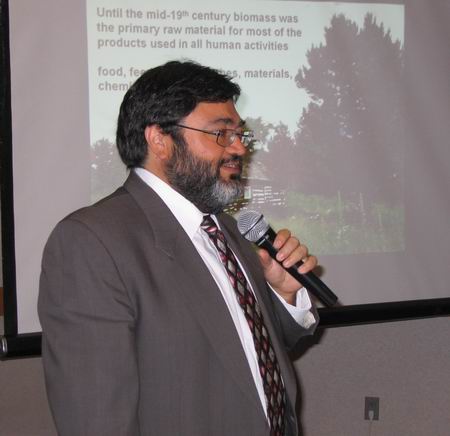BioEnergy: Buzz or Evolution?
By 250 News

Dr. Fernando Preto, talks about potential for Bioenergy (photo opinion250 staff)
Since the day the forest industry learned there was a limited shelf life for mountain pine beetle trees, there has been a push to diversify the economy of not only Prince George, but all northern communities which have many of their eggs in the same wood fiber basket.
Enter BioEnergy.
Energy produced through the burning of biofuels. Already in Canada, 6% of all energy used comes from biomass energy. 80% of the bioenergy is being used in the pulp and paper industry, the remaining 20 % is being used to heat our homes.
Canada already produces 200 million litres of bioethanol from grain products, and 200 million litres a year of biodiesel from waste fats and oils. Dr. Fernando Preto says that production level isn’t astounding, but “It is a start”. Preto is the Group Leader for Biomass Conversion in Natural Resources Canada’s CANMET Energy Technology Centre in Ottawa. He was the guest speaker at a Prince George Chamber of Commerce luncheon.
The buzz for Prince George has been the development of pellets for which there is a growing demand and market. The problem says Preto, is that there is no fiscal incentive to use this type of fuel, and cost is a major concern “The cost of converting the wood to bio mass energy has to be cost effective,” right now he says, the cost difference is too close to make it cost effective to switch to bio-mass. “There would have to be some sort of incentive, whether it is financial or a carbon credit, something, otherwise the cost of the energy will be too high.”
Will Government be willing to offer some incentive? “Your guess is as good as mine” says Preto.
Right now, pellets are being produced with the residue from sawmills, but market demand for dimensional lumber and plywood means that supply of residue may be difficult to obtain. “You have to have some other value added process so the costs are low”
Preto says there are also challenges for transportation fuels “ If we are looking for transportation fuels we need to look somewhere else. By the year 2025 we could be producing 4 billion litres of ethanol from grain, but that is only 5% of the Canadian fuel demand and to create that 4 billion litres, we used 20% of all the grain produced in Canada, doesn’t really sound very promising.”
Preto says “I think there is a lot of opportunity but I wouldn't think of harvesting it just for energy. I think you have to look at other things. For example, the pellet industry works right now here because they get their wood from sawmills which is a residue. So if you can harvest the pine for another use first, and have energy as well then you're o.k, but you have to have some higher value added thing you are going for. Just doing it for energy is more expensive."
Preto says there is a huge potential including using portable machines on site that can turn wood waste into a biofuel oil. The transportation problems are then reduced. "There is huge potential but it will take a little bit of investment and some dedication.”
Previous Story - Next Story
Return to Home









If there are a few lumber mills shut down in this area, then there will be a shortage of sawdust and hog fuel, it will be at this time that the pulp mills will flex their muscles and get the majority of the available hog fuel. This will create a problem for the pellet people.
For your information although most pellets are forwarded oveseas for fuel, a large part of this product has been sent into the United States to various horse farms, and racing academys and it is used in the horse stalls. Apparently it works much better than shavings or sawdust, in soaking up urine and other by products of oats. The problem again is the high transportation costs. By the time you ship a truckload to Kentucky you make a very small profit.